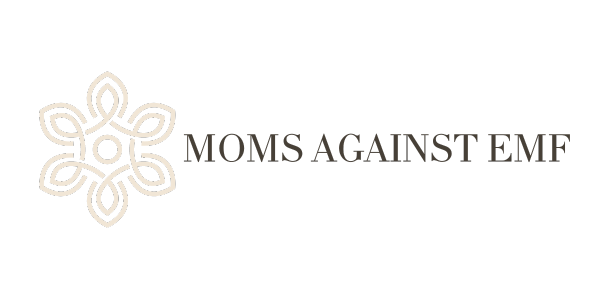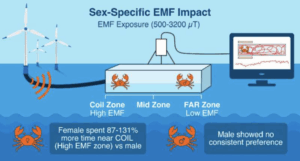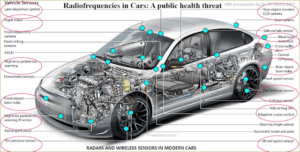As a first-time mom, learning and educating myself on environmental health has been a top priority for me in this new role. Nothing matters more to me than keeping my kid well and thriving in today’s technology-saturated world. Between managing screen exposure, worrying about food ingredients, and staying on top of environmental concerns, parenting can feel like navigating an overwhelming maze of information. That’s why I wanted to share my experience with an organization that has become an invaluable resource for me: Children’s Health Defense (CHD), founded by Robert F. Kennedy Jr.
Finding My Way to CHD
My journey with CHD began when I wanted to get more educated on the harms of EMF, research being done around it and why I needed to make protection a priority. Like many parents, I found myself researching potential connections between electromagnetic field (EMF) exposure and children’s health outcomes. What I discovered was alarming: children are particularly vulnerable to EMF exposure due to their developing nervous systems and thinner skulls, which allow for deeper penetration of radiation. Yes, cue the mind blown moment… Learn more about it here and here.
I felt lost among conflicting information until I found Children’s Health Defense and their library of comprehensive resources. What resonated with me was their commitment to presenting scientific research in an accessible way for parents who just want to protect their children.
Understanding the Science Behind EMF Concerns
Through CHD’s educational materials, I learned about a study from researchers at the University of Toronto and The Hospital for Sick Children that found children with higher exposures to magnetic fields in residences are two to four times more likely to develop leukemia than those with lower exposure. The risk was most significant in children under six years old.
This wasn’t alarmist propaganda; it was peer-reviewed research that should be brought to parents’ attention. CHD doesn’t just highlight problems—they explain the science behind EMF concerns in terms parents can understand and act upon.
How CHD Advocates Through Legal Action
What impressed me most about CHD is their willingness to challenge powerful institutions when children’s health is at stake. In August 2021, they won a landmark case against the Federal Communications Commission (FCC) in the U.S. Court of Appeals for the D.C. Circuit. The court ruled that the FCC failed to provide a reasoned explanation for why its outdated 1996 guidelines on radiofrequency radiation exposure adequately protect against harmful effects, particularly concerning non-cancer health effects and impacts on children.
They’ve also supported litigation for individuals suffering from electromagnetic sensitivities (EMS), helping me understand that these sensitivities are recognized under the Americans with Disabilities Act. In one case I read about through their newsletter, they supported Henry “Hank” Allen who sued Verizon Wireless after a cell tower near his home triggered life-threatening cardiac episodes and other symptoms.
Learn more from CHD Leaders on Digital Social Hour Podcast
Taking Action in Our Communities
When communities are facing the installation of a 5G cell tower near schools or homes, CHD can help guide the blocking of these from ever being put on the ground. I discovered that CHD has been actively involved in similar situations across the country, including a case in Belmar, New Jersey, where they supported residents in a lawsuit against Verizon’s plans to install 5G cell towers along a historic boardwalk.
Through CHD’s local chapters, you can connect with other concerned parents and receive:
- Template letters for communicating with local officials
- Scientific resources to include in public comments
- Legal precedents from similar situations in other communities
- Strategies that had worked in other neighborhoods
Their guidance helps community groups engage constructively with local officials about appropriate placement considerations, focusing on evidence-based concerns rather than just emotional arguments.
The Power of Local Chapters
What many parents don’t realize is that CHD works through local chapters across the country. In Arizona, for example, they merged with Arizonans for Safe Technology to form AZ4SafeTech, which works to protect neighborhoods by promoting safer technologies and educating the public about health risks associated with radiation exposure.
Local chapters connect with professionals across various fields—from environmental science to medicine—who help educate about the implications of increasing EMF exposure in local communities. This interdisciplinary approach gives individuals confidence that the concerns aren’t coming from a single perspective but represent a consensus across multiple domains of expertise.
Practical Steps for Reducing EMF Exposure
Beyond advocacy, CHD provides families with practical guidance for reducing EMF exposure at home such as:
- Using wired connections instead of Wi-Fi when possible
- Keeping devices out of bedrooms, especially children’s rooms
- Turning off Wi-Fi routers at night
- Maintaining distance between wireless devices and our bodies
- Advocating for hardwired internet connections in schools
These small changes are manageable and give peace of mind for those looking to take an active step in the protection direction from EMF exposure.
A Resource, Not a Replacement
What I appreciate most about CHD is that they view their role as empowering parents with information, not replacing our individual decision-making. They treat EMFs as an environmental pollution issue that affects not just human health but also our broader ecosystem.
Their approach isn’t about creating fear but about giving parents tools to advocate for healthier environments for all children. As a mom, this respectful approach to parent education resonates with me far more than dismissive assurances that we shouldn’t worry about emerging technologies.
Getting Connected
If you’re concerned about EMF exposure or other environmental factors affecting your children’s health, CHD offers several ways to connect:
- Their website houses an extensive library of scientific studies, expert opinions, and articles discussing the biological effects of EMF exposure
- Local chapters host community meetings and educational events
- Their newsletter provides updates on new research, legal actions, and policy developments
- You can join local safe technology groups that challenge the proliferation of wireless devices and infrastructure in sensitive locations
Moving Forward Together
Motherhood has taught me that advocating for our children’s health sometimes means asking difficult questions and seeking information beyond mainstream sources. Organizations like Children’s Health Defense have helped me find my voice as a parent advocate, providing the resources I needed to make informed decisions for my family.
In a world where children face evolving environmental challenges, having access to research-based information feels more important than ever. I’m grateful for CHD’s willingness to stand up for children’s health in the courtroom, in communities, and through educational initiatives that help parents like me navigate complex issues like EMF exposure.
Learn more about EMF exposure in schools, one of the biggest hot spots for school-age children here.
Great, I’ll gather both the research studies that Children’s Health Defense (CHD) cites directly and independent peer-reviewed studies that support concerns over EMF exposure and children’s health. I’ll organize them clearly, noting which ones are promoted by CHD and which are broader scientific sources. I’ll get back to you shortly with a detailed overview.
EMF Studies Cited by CHD and Supporting Stricter Regulation
Studies cited or promoted by CHD
- NTP Technical Report on Cell-Phone RFR in Rats (NTP, 2018) – National Toxicology Program (U.S. Dept. of Health/Human Services); TR-595 published Nov 2018. This two‐year animal study exposed rats to high levels of 900 MHz cell-phone radiation. In male rats, NTP found “clear evidence of carcinogenic activity” – namely, significantly elevated rates of malignant schwannomas in the heart – and “some evidence” of malignant gliomas in the brain (Abstract for TR-595). CHD highlights this as direct evidence that chronic RF radiation can cause cancer in mammals. (It notes that current FCC limits only guard against thermal effects, not such non-thermal tumors.) Relevance: The NTP findings helped motivate CHD’s FCC lawsuit and underscore CHD’s demand for updated, health-based RF standards beyond the 1996 thermal guidelines (Abstract for TR-595). (Study cited by CHD.)
- Hardell et al., “Childhood Brain Tumour Risk and Wireless Phones” (Environ. Health, 2011) – Fredrik Söderqvist, Michael Carlberg, Kjell Hansson Mild & Lennart Hardell; Open-access Environmental Health (Dec 2011). This expert commentary reviews evidence on cell-phone use and childhood brain tumors. Hardell’s group notes that while the Danish CEFALO study (on 7–19 year-olds) reported no increased risk, the underlying data “contain several indications of increased risk” (Childhood brain tumour risk and its association with wireless phones: a commentary | Environmental Health | Full Text). In particular, they point out that long-term adult studies show significantly higher glioma and acoustic neuroma risk for ipsilateral users, and they argue that CEFALO’s null result should not be taken as “reassuring evidence” given its design limitations (Childhood brain tumour risk and its association with wireless phones: a commentary | Environmental Health | Full Text). Relevance: By emphasizing possible childhood risk from long-term wireless use, Hardell et al. support CHD’s calls to limit children’s exposures (for example, banning school-based cell towers and recommending distance). (Study promoted by CHD.)
Independent peer-reviewed studies supporting CHD’s concerns
- Jin-Hwa Moon, “Health Effects of Electromagnetic Fields on Children” (Clin. Exp. Pediatrics, 2020) – Moon J-H. Clinical and Experimental Pediatrics 63(11):422–428 (May 2020). This peer-reviewed review notes that children’s developing brains are more vulnerable to EMF (their skulls are thinner, and RF penetration is deeper), and that the IARC has classified both ELF and RF fields as “possibly carcinogenic” (Group 2B) based on childhood leukemia and other evidence ( Health effects of electromagnetic fields on children – PMC ) ( Health effects of electromagnetic fields on children – PMC ). Moon concludes that, although definitive studies in children are hard to do, “precautionary principles should be followed” and EMF exposure among children “should be minimized” ( Health effects of electromagnetic fields on children – PMC ). The paper explicitly urges giving weight to clinical and epidemiological concerns and calls for research on 5G effects in children. Relevance: This independent pediatric review underpins CHD’s stance by urging precautionary policy and minimized exposures for children, based on potential cancer and neurological risks ( Health effects of electromagnetic fields on children – PMC ) (The sensitivity of children to electromagnetic fields – PubMed).
- Seomun et al., “ELF Magnetic Fields and Childhood Cancer” (PLOS ONE, 2021) – G. Seomun, J. Lee, J. Park; PLOS ONE 16(5):e0251628 (May 2021). In a systematic review and meta-analysis of 33 studies (~186,000 children), this study assessed childhood cancer risks from extremely low-frequency (ELF) magnetic fields (e.g. power lines). It found that living in areas with higher ELF-MFs was associated with significantly elevated odds of childhood leukemia: for example, exposure ≥0.4 µT (the usual 0.2–0.4 µT threshold) gave OR ≈1.72 (95% CI: 1.25–2.35) for leukemia (Exposure to extremely low-frequency magnetic fields and childhood cancer: A systematic review and meta-analysis | PLOS One). (There was weaker or non-significant elevation for brain tumors and all cancers.) The authors note “significant associations” and even a dose–response trend for leukemia, acknowledging that IARC had already labeled ELF as possibly carcinogenic (Exposure to extremely low-frequency magnetic fields and childhood cancer: A systematic review and meta-analysis | PLOS One) (The sensitivity of children to electromagnetic fields – PubMed). Relevance: This rigorous review shows that even current power-line level fields (~0.2–0.4 µT) significantly raise childhood leukemia risk (Exposure to extremely low-frequency magnetic fields and childhood cancer: A systematic review and meta-analysis | PLOS One). CHD cites such evidence to argue that regulatory limits (which do not account for childhood leukemia risk) are insufficient, reinforcing calls for stricter ELF and RF controls.
- Leeka Kheifets et al., “The Sensitivity of Children to Electromagnetic Fields” (Pediatrics, 2005) – L. Kheifets et al.; Pediatrics 116(2):e303–e313 (Aug 2005). Although older, this World Health Organization–sponsored review highlights that children’s physiology (developing nervous systems, smaller size) likely makes them more sensitive to EMF. It notes that epidemiology on childhood leukemia and ELF fields led IARC to call ELF a “possible human carcinogen” (The sensitivity of children to electromagnetic fields – PubMed). The paper concludes by endorsing precautionary policies: recommending further research and public policies to protect children in the face of uncertainty (The sensitivity of children to electromagnetic fields – PubMed) (The sensitivity of children to electromagnetic fields – PubMed). Relevance: Kheifets et al. argue for precaution due to children’s vulnerability (The sensitivity of children to electromagnetic fields – PubMed). Although CHD did not conduct this study, it cites Kheifets’s conclusions to bolster its claim that existing guidelines overlook children’s risks.
- Simkó & Mattsson, “5G Wireless and Health Effects” (Int. J. Environ. Res. Public Health, 2019) – M. Simkó & M.-O. Mattsson; 16(18):3406 (Sept 2019). This systematic review examined 94 studies on millimeter-wave (6–100 GHz) exposures (the high bands used in 5G). It found that 80% of in vivo (animal) studies and 58% of in vitro studies reported some biological effect from these low‐level exposures ( 5G Wireless Communication and Health Effects—A Pragmatic Review Based on Available Studies Regarding 6 to 100 GHz – PMC ). Although the review notes inconsistent methods and calls for better-designed studies, its key finding is that a majority of experiments do see responses (across endpoints like gene expression, cell signaling, etc.) ( 5G Wireless Communication and Health Effects—A Pragmatic Review Based on Available Studies Regarding 6 to 100 GHz – PMC ). Relevance: By showing that most 5G-frequency studies report effects, this peer-reviewed review supports CHD’s contention that 5G (even at non-thermal levels) may not be risk-free. It underscores CHD’s demand for caution and further research before roll-out of higher-frequency networks ( 5G Wireless Communication and Health Effects—A Pragmatic Review Based on Available Studies Regarding 6 to 100 GHz – PMC ).
- Tahmaseb et al., “In Utero Wi-Fi Exposure Impairs Fetal Growth” (J. Pub. Health in Africa, 2023) – S. Tahmaseb et al.; J Public Health Afr. 13(2):1968 (Jun 2023). This rat study exposed pregnant females to 2.45 GHz Wi-Fi radiation and measured offspring growth and brain chemistry. It found that Wi-Fi exposure “blocked body growth” in the pups and significantly reduced BDNF levels (a key brain-growth factor) compared to controls ( A primary study on rat fetal development and brain-derived neurotrophic factor levels under the control of electromagnetic fields – PMC ). In other words, exposed fetuses were smaller and had lower brain-growth signals. Relevance: Though in rats, these findings align with CHD’s concern that prenatal/neonatal EMF exposure could harm development. CHD cites such animal evidence to argue that the effects on human children are unknown and possibly serious, urging tighter exposure limits for pregnant women and infants ( A primary study on rat fetal development and brain-derived neurotrophic factor levels under the control of electromagnetic fields – PMC ).
- Wang et al., “Cognitive Effects of Prenatal 1800/2400 MHz Exposure” (J. Radiat. Res., 2020) – H. Wang et al.; J Radiation Research 61(3):369–378 (2020). This experiment exposed pregnant rats to 1800 MHz (cellular) and 2400 MHz (Wi-Fi) fields and assessed offspring behavior. The exposed offspring showed altered development: for example, delayed motor performance and anxiety-like behavior in maze tests, along with significant changes in brain NMDA receptor gene expression ( Testing of behavioral and cognitive development in rats after prenatal exposure to 1800 and 2400 MHz radiofrequency fields – PMC ) ( Testing of behavioral and cognitive development in rats after prenatal exposure to 1800 and 2400 MHz radiofrequency fields – PMC ). The authors conclude that prenatal RF exposure “may affect the behavioral and cognitive development of offspring rats” and note disrupted hippocampal receptors ( Testing of behavioral and cognitive development in rats after prenatal exposure to 1800 and 2400 MHz radiofrequency fields – PMC ). Relevance: These results suggest that fetal/neonatal EMF exposure could impair neurodevelopment. CHD uses such studies to argue that current guidelines ignore subtle neurodevelopmental effects on children and to demand precautionary exposure reductions for pregnant women and children ( Testing of behavioral and cognitive development in rats after prenatal exposure to 1800 and 2400 MHz radiofrequency fields – PMC ).
Sources: All studies above are peer-reviewed and published in scientific journals (links provided). CHD’s own materials frequently reference these findings or related data to support its advocacy for stronger EMF safety regulations. Studies listed as “cited by CHD” are ones CHD has explicitly highlighted; the others are independent studies aligning with CHD’s concerns.







